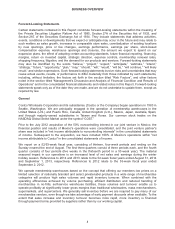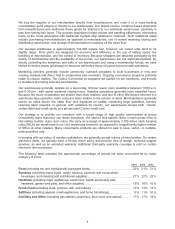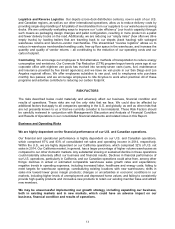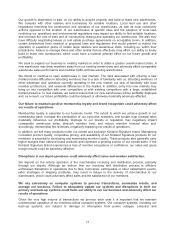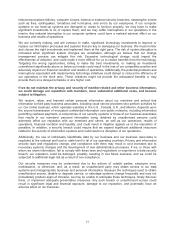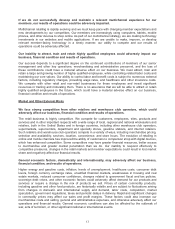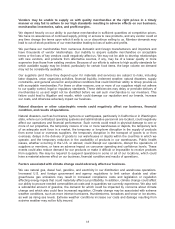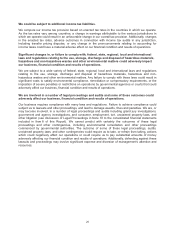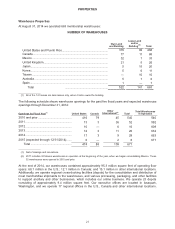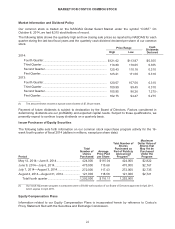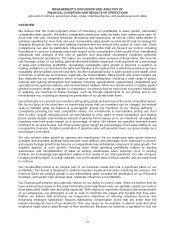Costco 2014 Annual Report Download - page 20
Download and view the complete annual report
Please find page 20 of the 2014 Costco annual report below. You can navigate through the pages in the report by either clicking on the pages listed below, or by using the keyword search tool below to find specific information within the annual report.Vendors may be unable to supply us with quality merchandise at the right prices in a timely
manner or may fail to adhere to our high standards resulting in adverse effects on our business,
merchandise inventories, sales, and profit margins.
We depend heavily on our ability to purchase merchandise in sufficient quantities at competitive prices.
We have no assurances of continued supply, pricing or access to new products, and any vendor could at
any time change the terms upon which it sells to us or discontinue selling to us. Member demands may
lead to out-of-stock positions of our merchandise leading to loss of sales and profits.
We purchase our merchandise from numerous domestic and foreign manufacturers and importers and
have thousands of vendor relationships. Our inability to acquire suitable merchandise on acceptable
terms or the loss of key vendors could negatively affect us. We may not be able to develop relationships
with new vendors, and products from alternative sources, if any, may be of a lesser quality or more
expensive than those from existing vendors. Because of our efforts to adhere to high quality standards for
which available supply may be limited, particularly for certain food items, the large volume we demand
may not be consistently available.
Our suppliers (and those they depend upon for materials and services) are subject to risks, including
labor disputes, union organizing activities, financial liquidity, inclement weather, natural disasters, supply
constraints, and general economic and political conditions that could limit their ability to timely provide us
with acceptable merchandise. For these or other reasons, one or more of our suppliers might not adhere
to our quality control, legal or regulatory standards. These deficiencies may delay or preclude delivery of
merchandise to us and might not be identified before we sell such merchandise to our members. This
failure could lead to litigation and recalls, which could damage our reputation and our brands, increase
our costs, and otherwise adversely impact our business.
Natural disasters or other catastrophic events could negatively affect our business, financial
condition, and results of operations.
Natural disasters, such as hurricanes, typhoons or earthquakes, particularly in California or in Washington
state, where our centralized operating systems and administrative personnel are located, could negatively
affect our operations and financial performance. Such events could result in physical damage to one or
more of our properties, the temporary closure of one or more warehouses or depots, the temporary lack
of an adequate work force in a market, the temporary or long-term disruption in the supply of products
from some local or overseas suppliers, the temporary disruption in the transport of goods to or from
overseas, delays in the delivery of goods to our warehouses or depots within the countries in which we
operate, and the temporary reduction in the availability of products in our warehouses. Public health
issues, whether occurring in the U.S. or abroad, could disrupt our operations, disrupt the operations of
suppliers or members, or have an adverse impact on consumer spending and confidence levels. These
events could also reduce demand for our products or make it difficult or impossible to receive products
from suppliers. We may be required to suspend operations in some or all of our locations, which could
have a material adverse effect on our business, financial condition and results of operations.
Factors associated with climate change could adversely affect our business.
We use natural gas, diesel fuel, gasoline, and electricity in our distribution and warehouse operations.
Increased U.S. and foreign government and agency regulations to limit carbon dioxide and other
greenhouse gas emissions may result in increased compliance costs and legislation or regulation
affecting energy inputs that could materially affect our profitability. In addition, climate change could affect
our ability to procure needed commodities at costs and in quantities we currently experience. We also sell
a substantial amount of gasoline, the demand for which could be impacted by concerns about climate
change and which also could face increased regulation. Climate change may be associated with extreme
weather conditions, such as more intense hurricanes, thunderstorms, tornadoes and snow or ice storms,
as well as rising sea levels. Extreme weather conditions increase our costs and damage resulting from
extreme weather may not be fully insured.
18


